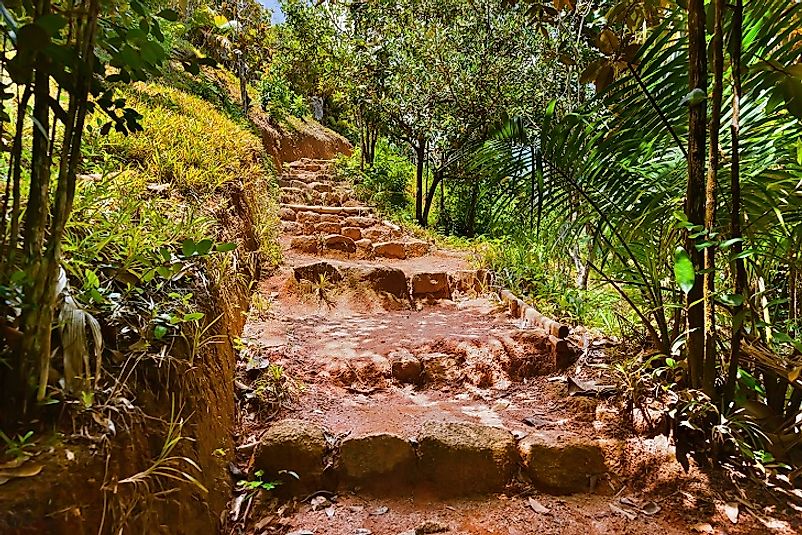Vallée de Mai Nature Reserve, Praslin Island, Seychelles

Vallée de Mai houses some of the world's unique specimens of palm trees and their noteworthy seeds. The Coco de Mer, a monocot tree endemic to these palm forests, has the largest seeds in the world. The reserve provides a habitat for the coexistence of five endemic palms as well as many native avian fauna species and other animals. The arrangement of the palm tree around and in reserve provides an outstanding aesthetic and ecological beauty. The vast forest, the lush green landscape, and the tropical sunshine provide a vibrant ecosystem.
5. Climate and Geography -
Praslin Island houses the reserve, and the area is well known for Fond Azore, its highest mountain, which is seen rising to around 373 meters above sea level. The Island is 37 square kilometers in area, and located some forty-five miles northeast of the island of Mahe. The island has a granitic rock as the primary geological formation. The islands size makes it subject to marine influences although the climate is quite humid. From May to November the southeast trade winds blow over the island country of Seychelles. From December to April hot, wet weather sets. The rainy season starts in December and continues throughout March in spurts of intense storms.
4. Natural History-
Before the 1930s, the park existed as an undisturbed virgin forest. On April 18, 1966, it received a Nature Reserve status under global Bird Protection Regulations. In 1979, its status changed to a National Park for better preservation and conservation efforts under the National Parks and Nature Conservancy Act. In 1983, UNESCO inscribed the site as its smallest natural world heritage site up to that time.
3. Scientific and Ecological Significance -
Shaped by years of geological and biological processes, the Vallée de Mai Nature Reserve is an outstanding example of the evolutionary history of the natural world's tropical flora. The ecology is dominated by the famous Coco-de-Mer Palm, which has the biggest seeds in the Plant Kingdom. The endemic species of flora and fauna provides a living laboratory of ancient life before the advent of the more advanced plant species. The endemic palm trees dominating the region represent an outstanding example of a biological evolution dominated by native trees, and the preservation of these trees is almost primeval. The coexistence of ancient palm tree-filled dense forests, alongside the broadleaf trees and Pandanus screw palms, forms a unique ecological region of nutrient cycling, pollination, and seed dispersal.
2. Habitats and Biodiversity -
The Vallée de Mai Nature Reserve provides a habitat for the growth of the Coco de Mer Palm, a flagship species of global significance, which bears the largest double-nut and largest seed in the world. The stilt roots are indistinguishable from the trunk, with round and oval-shaped fruits. Other plant species growing in the area are the millionaire's salad Seychelles stilt palm, thief palm, latanier palm, and the Latanier millepattes, which is unique to Seychelles only. The forests are dense with broad leaf trees and Pandanus screw palms. The Chrysobalanus icaco Cocoplum, with its beauty array of red, green, and brown fronds, also grows here. There are also two endemic trees, the bwa rouz Dillena furruginea and the Kapisen Northea hornei. The prominent animals are the endemic and global species of Seychelles black parrot, Seychelles blue pigeon, Seychelles bulbul, Seychelles Sunbird, and Seychelles kestrel. Other animals are the tiger chameleon, Seychelles skink, Wrights skink, caecilians, and three frogs. Gecko species include the Seychelles small day gecko and the Seychelles giant gecko. Reptile species include the Seychelles house snake and Seychelles wolf snake. There are also six caecilians species living in the deep moist soil layers of the ecosystem. Unique mollusks, such as the Praslin Snails with their twirled and pointed shells, thrive in the park. The golden panchax is the only freshwater fish endemic to Seychelles.
1. Environmental Threats and Conservation Efforts-
The Vallée de Mai Nature Reserve is under national legislative protection, and is managed by a public trust founded by the Seychelles Islands Foundation. Fire is the most significant threat facing the reserve and as such fire responses and contingencies plan need evaluation. The over-exploitation of Coco de Mer Palms is exhausting the natural reproduction of the trees, and the illegal removal of seeds affects future regeneration. Conservation approaches include maintenance of the palm trees by collecting and planting seeds before they are stolen. Other conservative measures include removal of invasive species and treating or preventing diseases.











